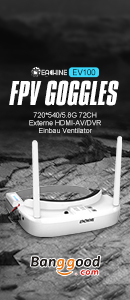In der Beschreibung steht efolgendes drin:
**** 11 - GPS (optionnal) *********************************************************************************************
* It is possible to connect a GPS module to Arduino. In this case, oXs will transmit to the Tx some data generated by the GPS module.
* Note: data are sent to the receiver only when the GPS has a fix.
* So, it can take several minutes before oXs start sending GPS data.
* If GPS lost his fix, oXs will stop sending GPS data until GPS got a new fix.
* When Frsky (SPORT or HUB) receiver is used, oXs will always send longitude, latitude, altitude, ground speed and course.
* This does not require any additional lines in the section "Data to transmit" (see 9 here above)
* When Multiplex receiver is used, the user has well to specify under the line "#define SETUP_MULTIPLEX_DATA_TO_SEND" which data are sent and the line number where the data have to appear on the display.
* Hardware points of attention.
* Supported GPS modules: oXs supports modules based on UBLOX GPS (easily available on ebay or aliexpress) like Neo6M, Neo7M and Neo8M.
* Most modules have a build in voltage regulator in order to drop the voltage down to 3.3 volt which is about the max allowed by the GPS
* They have 4 pins available that have to be connected to Arduino
* - GPS gound is connected to Arduino ground
* - GPS Vcc is normally connected to Arduino Raw pin (which is normally connected to Vcc from the receiver).
* Still take care that the voltage regulator on the GPS module is, most of the time, foreseen for a maximum voltage of 6 Volt while arduino Raw pin accept more.
* So, if you Raw pin get more that 6 volt, it is safe to add another voltage regulator to drop the GPS Vcc down.
* - GPS Tx pin is connected to Arduino Rx pin
* - GPS Rx pin is connected to a resistor (e.g. 10k) and the other pin of the resistor is connected to Arduino pin 6 (digital pin 6).
* This resistor is added (at least for a Arduino 5 volt) in order to protect the GPS pin.
* This is requested because Arduino will generate a signal with a high level equal to arduino Vcc (so normally 5 volt) while the GPS module should normally not accept more than 3.3 Volt.
* To be safier, you could even add a second resistor between GPS Rx pin and Ground (value= 22k) but, in my case, it worked without this second resistor.
* Note: it would be possible to use another pin than Arduino pin 6 but then it requires to change some parameters in file oXs_gps.cpp (see "Setup the GPS sensor").
* !! IMPORTANT NOTE :
* Arduino Rx pin is used for 2 purposed: getting the data from the GPS and uploading the program into the Arduino (normally only to be done once) using a USB to serial adapter.
* You must avoid having both GPS and USB connected at the same time because while uploading a program in Arduino, there will be conflicts between the signals sent by the 2 devices and programming will fail.
* There is another risk: if your USB to serial adapter generates 5 volts signal, it could damage the GPS module.
* So, when you connect the usb to serial adapter to the Arduino, you should disconnect at least the GPS TX pin from the Arduino Rx pin.
* Personnaly I use a connector between Arduino and GPS module and so I can disconnect totally the GPS module.
* Software points of attention
* UBLOX GPS module are normally delivered with a default configuration (generating automatically e.g some NMEA messages at 9600 bauds at a refresh rate of 1 hz).
* oXs assumes that, at start up, GPS is working at 9600 bauds. oXs sent then some commands in order to
* - disable all NMEA messages
* - activates some UBX messages
* - increase frequency of calculation (to 5 Hz instead of 1hz)
* - set up the baud rate to 38400 instead of 9600.
* Those parameters are not saved in the GPS (because some GPS modules does not allow it). So, oXs will send those commands at each power on.
* If you oXs does not send GPS data, please check that your GPS module has still the default configuration (most important is that it is configured to receive UBX command messages at 9600 bauds).
* An easy way to check the GPS configuration is to connect the GPS module to a 3.3 volt FTDI ( or USB to serial adapter) and to use a free software named "u-center".
* This software is available on the official web site of UBLOX. More info is easily available on the web.
* OXs allows to modify some parameters in the config.h file:
* - #define GPS_INSTALLED : uncomment this line if a GPS is connected and has to transmit his data
* - #define GPS_SPEED_IN_KMH : uncomment this line if GPS speed has to be sent in km/h instead of knot/h
* - #define GPS_SPEED_3D : uncomment this line if GPS speed has to be the 3d speed instead of the 2d speed (note: 3d is probably less accurate - to test)
*
************************************************************************************************************************



















